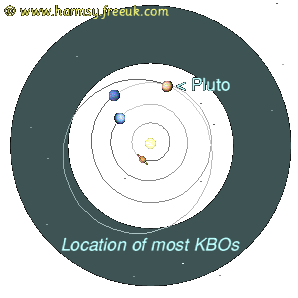
 |
The Kuiper Belt |
|
| |
 Most people think the Solar System ends with Pluto. This is not the case. The asteroids - leftover material from the formation of the solar system - between Mars and Jupiter are not all that remains from that violent time. Beyond the orbits of Neptune and Pluto lie a large number of small, icy bodies, making up what is known as the Kuiper Belt (pronounced Ky-per). Most people think the Solar System ends with Pluto. This is not the case. The asteroids - leftover material from the formation of the solar system - between Mars and Jupiter are not all that remains from that violent time. Beyond the orbits of Neptune and Pluto lie a large number of small, icy bodies, making up what is known as the Kuiper Belt (pronounced Ky-per).
Far Beyond PlutoFrom 1992 onwards, astronomers began to discover large numbers of these bodies orbiting beyond Neptune, between 30-50 AU. This is the Kuiper Belt. The image (above left) shows this historical discovery. [Image © David Jewitt, Hawaii University]At least 70,000 are known with diameters above 100 km. The vast majority, however, are between 10-50 km across, and so are very dim indeed.  Due to their vast distance from the Sun, they take hundreds of years to complete an orbit, and move very slowly. For all these reasons, detection is very difficult. Dutch InputThe Kuiper Belt is named after the famous Dutch astronomer, Gerard Kuiper [1905-73], who was a pioneer in solar system research using spacecraft. A list of his major contributions to astronomy are given below. He put forward a new theory of how the solar system was formed, and it is generally accepted today. People had believed that the planets had formed from material hurled off from the Sun. Kuiper argued that a gas and dust cloud collapsed under gravity, forming the Sun and planets separately. |
In His HonourIn 1951 he suggested that short-period comets (those coming from just beyond Pluto) originate from a collection of material left over from the formation. When the first KBOs were discovered, after Kuiper's death, the belt was named in his honour.Kuiper's MistakeHis one error was to deny the existence of any other divisions in Saturn's rings, except for Cassini's. This came about because he used the Palomar 200-inch reflector visually (i.e. with his eyes). Eyes are not as sensitive as photographic plates, so he dismissed the other (narrower) gaps in its rings as "ripples". An easy mistake to make!Kuiper's Contributions
Giant KBO Discovered!An icy, reddish KBO - dubbed 2001 KX76 - was recently discovered. Over 1,000 km across, it's as big as Pluto's moon! There may be many more like it - some perhaps even larger than Pluto itself. For more on this, click here. Related Topic: Oort Cloud |
|
Sun | Mercury | Venus | Earth | Moon | Mars | Asteroids | Jupiter | Saturn | Uranus | Neptune | Pluto | X | Kuiper | |